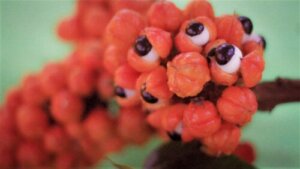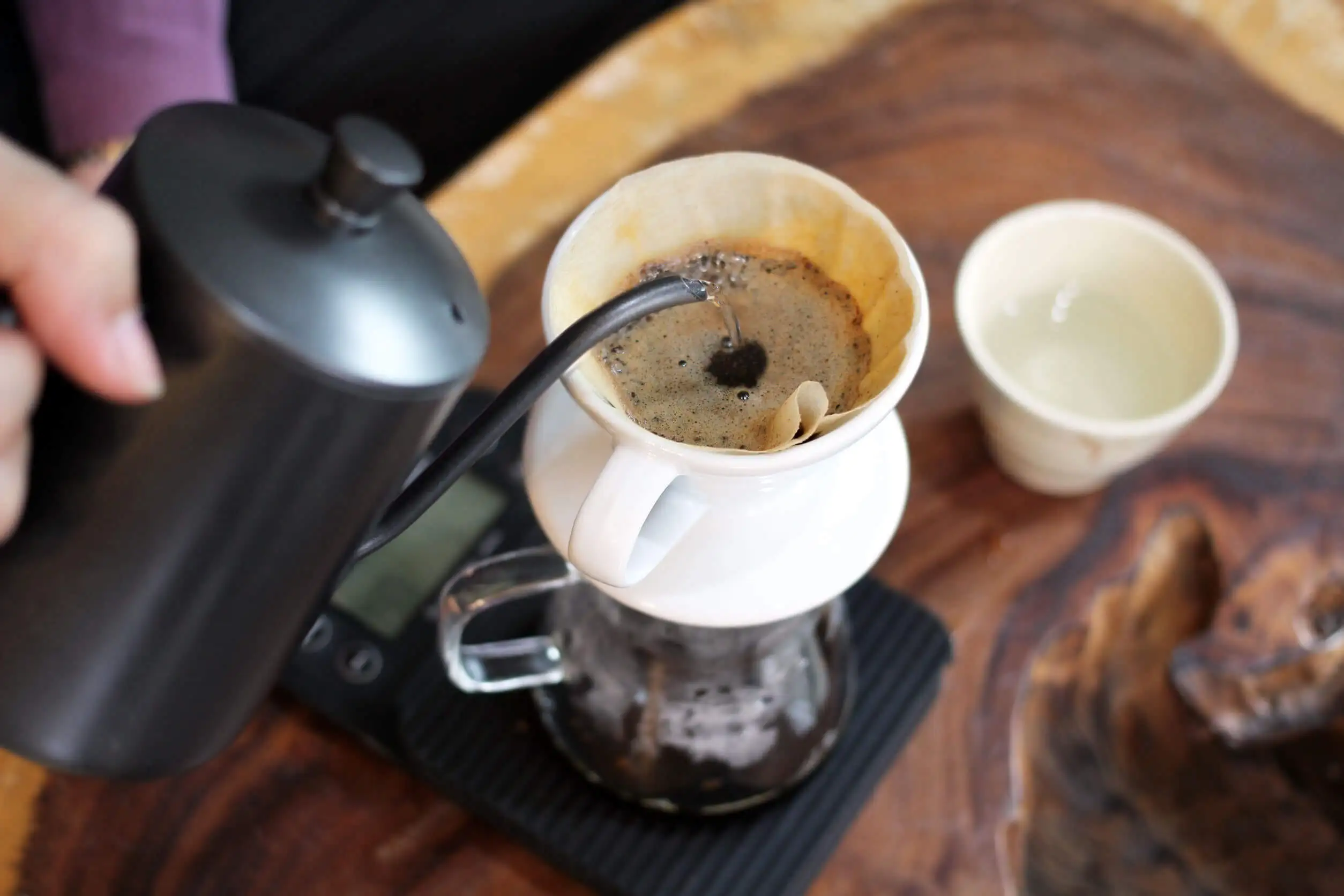Guarana: Uses, Properties, and Contraindications

Guarana, whose scientific name is Paullinia cupana, is a climbing plant that grows in the Amazon. For centuries, the tribes of this region have used the fruit and other parts of the plant for various therapeutic purposes. In particular, it’s valued for its abundant supply of stimulants, such as caffeine, theophylline, and theobromine.
In fact, as detailed in a publication in Evidence-Based Complementary and Alternative Medicine, it’s an ingredient that’s often used in the preparation of energy and sports drinks due to its ability to boost the functions of the nervous system, heart and muscles. Want to know more about it?
The uses and properties of guarana
Guarana (Paullinia cupana) is a plant with a long, flexible stem, whose fruit resembles a nut kernel. In the Amazon region, the indigenous people use this food to prepare a stimulating drink with characteristics similar to tea or coffee. To be more precise, its seeds provide up to 6% caffeine.
According to information shared in the Journal of Ethnopharmacology, 70% of guarana production is currently destined for the energy drink and soft drink industry. The other 30% is pulverized for consumption through capsules or diluted.
It’s even added in cosmetic products. So, what are its properties?
Like this article? You may also like to read: Why it’s Important to Eat Fruit and Vegetables According to WHO
Guarana helps reduce fatigue
One of the most important properties of guarana comes from its caffeine content. As stated in an article published in Food Research International, the seeds of this ingredient provide between 4 and 6 times more caffeine than coffee.
Therefore, it’s a good option to increase energy levels and reduce fatigue. In a study shared in the journal Appetite, a group of people who took a vitamin supplement with guarana reported feeling less fatigued after several tests.

It may support weight loss
Guarana supplements do not work miraculously for weight loss.
However, its consumption as part of a healthy, balanced diet does bring some benefits. Specifically, test tube studies suggest that this fruit helps suppress genes that aid in the production of fat cells.
In addition, its abundant caffeine content speeds up metabolism, which translates into an increased ability of the body to burn calories at rest. While more human studies are needed, the findings are considered promising.
Guarana supports digestive health
The compounds in guarana have been harnessed in natural medicine as allies for stomach health. To be more precise, it’s considered a remedy for calming diarrhea. Due to its tannin content, it acts as an astringent and restricts the amount of liquid secreted in the intestines.
Meanwhile, its caffeine content helps stimulate intestinal peristalsis, which activates the contractions of the intestines and colon to relieve constipation.
It helps to take care of visual health
The abundant antioxidant content of guarana is beneficial for visual health. According to a publication in the journal Diseases, these substances help slow the effects of oxidative stress, which reduces the risk of cataracts, glaucoma, and age-related macular degeneration.
In research revealed by the Journal of Functional Foods, participants who consumed guarana on a regular basis had better self-reported vision compared to those who didn’t.
In addition, it was observed that this food helped decrease DNA damage and eye cell death when compared to a placebo. However, more human studies are still needed.
It protects cardiovascular health
The caffeine and catechins contained in guarana have a positive effect on cardiovascular health. According to a study shared in the International Journal for Vitamin and Nutrition Research, these compounds have antiplatelet aggregation properties and therefore reduce the risk of thrombosis and heart disease.
In turn, as reported in Lipids in Health and Disease, guarana helps reduce the oxidation of “bad” cholesterol (LDL) by up to 27%.
It has analgesic effects
Guarana has been used as an adjuvant to relieve various types of pain. Its analgesic properties derive from its caffeine content, a stimulant that blocks adenosine receptors (responsible for pain sensation).
A review shared in the Cochrane Library details that caffeine significantly improves the effects of analgesics. For this reason, it’s commonly found in the formula of several medications for this purpose.
Guarana contributes to skincare
In the cosmetic industry, guarana is often used to improve the formula of creams, lotions, soaps and anti-aging products. The reason? It’s caffeine, antioxidants, and antimicrobial properties help skincare.
A review reported in Skin Pharmacology and Physiology comments that caffeine stimulates the degradation of fats and therefore favors the reduction of cellulite. In addition, it helps protect the dermis against ultraviolet (UV) radiation and slows down the aging process.
Another study details that guarana significantly reduces age-related skin damage thanks to its high antioxidant content.
It has antimicrobial properties
The antimicrobial properties of guarana are largely explained by its tannin, catechins, and caffeine content. A study in the journal Molecules details that extracts of this ingredient help fight microorganisms such as Streptococcus mutans, which is present in dental plaque.
Previous studies have determined that it also acts against other bacteria, such as Escherichia coli, which is associated with episodes of diarrhea and digestive diseases.
It has antitumor properties
Research has evaluated the antitumor potential of guarana. Thus, it has been observed that it can protect against DNA damage and inhibit the growth of cancer cells. However, these studies have been done in test tube and animal studies, so human trials are still required.

The risks and contraindications of guarana
Generally speaking, guarana has a good safety profile. Studies indicate that it has low toxicity when used in low or moderate doses.
However, when consumed in excessive amounts it is associated with the following side effects:
- Anxiety
- Insomnia
- Convulsions
- Nervousness
- Abdominal pain
- Headaches
- Alteration of the cardiac rhythm
Added to the above, it should be remembered that caffeine can generate dependence. In addition, it’s contraindicated for pregnant women, due to the risk of miscarriage or fetal abnormalities.
Other contraindications are the following:
- A history of allergy to caffeine
- Children under 12 years old
- People with gastroduodenal ulcers
- Patients under treatment with antidepressants
It should be noted that guarana does not replace a healthy diet or medical treatments. Before taking such supplements, it’s best to consult a doctor or specialist.
We think you may be interested in reading this, too: Say Goodbye to Constipation with These 8 Fruit Smoothies
What to remember about guarana
Guarana is valued for its energizing power and abundant antioxidant content. Right now, it’s a widely used ingredient in the production of sports or energy drinks. In addition, it’s also used in cosmetics and natural medicine.
Due to its stimulant content, especially caffeine, its intake is associated with improved productivity, better mood and lower risk of disease. Even so, its consumption should be moderate and preferably under professional supervision.
All cited sources were thoroughly reviewed by our team to ensure their quality, reliability, currency, and validity. The bibliography of this article was considered reliable and of academic or scientific accuracy.
- Biblioteca Nacional de Medicina de Estados Unidos. (28 de agosto de 2023). Guaraná. Medlineplus. Consultado el 20 de octubre de 2023. https://medlineplus.gov/spanish/druginfo/natural/935.html#Dosage
- Bonadiman, B. S. R., Cadoná, F. C., Assmann, C. E., Weis, G. C. C., de Oliveira Alves, A., Frescura Duarte, M., Chaves, C. M., do Carmo Chaves, C., dos Santos Motta, K. M., Esteves Ribeiro, E., Dulce Bagatini, M., & Mânica da Cruz, I. B. (2017). Guarana (Paullinia cupana): cytoprotective effects on age-related eye disfuntion. Journal of Functional Foods. 36: 375-386. https://www.sciencedirect.com/science/article/abs/pii/S1756464617304152
- Canadian Academy of Sports and Nutrition. (s.f.). Guarana. Consultado el 19 de octubre de 2023. https://www.caasn.com/guarana.html
- D’Angelo, S., & Ascione, A. (2020). Guarana and physical performance: a myth or reality? Journal of Human Sport and Exercise, 15(3), 539-551. https://www.researchgate.net/publication/344832416_Guarana_and_physical_performance_A_myth_or_reality
- Derry, C. J., Derry. S., & Moore, R. A. (2012). Caffeine as an analgesic adjuvant for acute pain in adults. Cochrane Database Systematic Reviews. 14 (3): CD009281. https://pubmed.ncbi.nlm.nih.gov/22419343/
- De Lima, Portella, R., Pillon Barcelona, R., Flores da Rosa, E, Esteves Ribeiro, E., Mânica da Cruz, I. B., Suleiman, L., & Antunes Soares, F. A. (2013). Guaraná (Paullinia cupana Kunth) effects on LDL oxidation in elderly people: an in vitro and in vivo study. Lipids in Health and Disease. 12,12. https://lipidworld.biomedcentral.com/articles/10.1186/1476-511X-12-12
- Da Silva, N., Numata E. P., Mendes, L., Dias P. H., Vilegas, W., Gambero, A., & Lima, L. (2017). Modulatory effects of Guarana (Paullinia cupana) on adipogenesis. Nutrients, 9(6) 1-11. https://www.ncbi.nlm.nih.gov/pmc/articles/PMC5490614/
- Patrick, M., Kim, H. A., Oketch-Rabah, H., Marles, R. J., Roe, A. L., & Calderón, A. I. (2019). Safety of guarana seed as a dietary ingredient: A review. Journal of agricultural and food chemistry, 67(41), 11281-11287. https://pubmed.ncbi.nlm.nih.gov/31539257/
- Peixoto, H., Roxo, M., Röhrig, T., Richling, E., Wang, X., & Wink, M. (2017). Anti-Aging and antioxidant potential of Paullinia cupana var. sorbilis: findings in Caenorhabditis elegans indicate a new utilization for roasted seeds of Guarana. Medicines. 4 (3):61. https://pubmed.ncbi.nlm.nih.gov/28930275/
- Pizzino, G., Irrera, N., Cucinotta M., Pallio, G., Mannino, F., Arcoraci, V., Squadrito, F., Altavilla, D., & Bitto, A. (2017). Oxidative stress: harms and benefits for human health. Oxidative Medicine and Cellular Longevity. 2017: 8416763. https://www.ncbi.nlm.nih.gov/pmc/articles/PMC5551541/
- Schimpl, F. C., da Silva, J. F., Gonçalves, J. F. de C., & Mazzafera, P. (2013). Guarana: Revisiting a highly caffeinated plant from the Amazon. Journal of Ethnopharmacology. 150 (1): 14–31. https://www.sciencedirect.com/science/article/abs/pii/S0378874113005771
- Torres E. A., Pinaffi-Langley, A. C., de Souza Figueira, Silva Cordeiro, K., Dias, Negrao, L., Jurema Soares, M., Pereira da Silva, C., Zsigovics Alfino, M. C., Rodrigues Sampaio, G., & Costa de Camargo, A. (2021). Effects of the consumption of guarana on human health: a narrative review. Comprehensive Reviews in Food Science and Food Safety, 21, 272-295. https://ift.onlinelibrary.wiley.com/doi/epdf/10.1111/1541-4337.12862
- Van Schaik L., Kettle, C., Green, R., Irving, H. R., & Rathner, J. A. (2021). Effects of caffeine on brown adipose tissue thermogenesis and metabolic homeostasis: a review. Frontiers in Neuroscience. 15. https://www.frontiersin.org/articles/10.3389/fnins.2021.621356/full
- Smith N, Atroch AL. Guaraná’s Journey from Regional Tonic to Aphrodisiac and Global Energy Drink. Evid Based Complement Alternat Med. 2010 Sep;7(3):279-82. doi: 10.1093/ecam/nem162. Epub 2007 Dec 5. PMID: 18955289; PMCID: PMC2887323.
- da Silva, G. S., Canuto, K. M., Ribeiro, P. R. V., de Brito, E. S., Nascimento, M. M., Zocolo, G. J., Coutinho, J. P., & de Jesus, R. M. (2017). Chemical profiling of guarana seeds ( Paullinia cupana ) from different geographical origins using UPLC-QTOF-MS combined with chemometrics. In Food Research International (Vol. 102, pp. 700–709). Elsevier BV. https://doi.org/10.1016/j.foodres.2017.09.055
- Kennedy DO, Haskell CF, Robertson B, Reay J, Brewster-Maund C, Luedemann J, Maggini S, Ruf M, Zangara A, Scholey AB. Improved cognitive performance and mental fatigue following a multi-vitamin and mineral supplement with added guaraná (Paullinia cupana). Appetite. 2008 Mar-May;50(2-3):506-13. doi: 10.1016/j.appet.2007.10.007. Epub 2007 Oct 30. PMID: 18077056.
- Dulloo AG, Geissler CA, Horton T, Collins A, Miller DS. Normal caffeine consumption: influence on thermogenesis and daily energy expenditure in lean and postobese human volunteers. Am J Clin Nutr. 1989 Jan;49(1):44-50. doi: 10.1093/ajcn/49.1.44. PMID: 2912010.
- de Jesus NZ, de Souza Falcão H, Gomes IF, de Almeida Leite TJ, de Morais Lima GR, Barbosa-Filho JM, Tavares JF, da Silva MS, de Athayde-Filho PF, Batista LM. Tannins, peptic ulcers and related mechanisms. Int J Mol Sci. 2012;13(3):3203-28. doi: 10.3390/ijms13033203. Epub 2012 Mar 8. PMID: 22489149; PMCID: PMC3317710.
- Lohsiriwat S, Kongmuang P, Leelakusolvong S. Effects of caffeine on anorectal manometric findings. Dis Colon Rectum. 2008 Jun;51(6):928-31. doi: 10.1007/s10350-008-9271-y. Epub 2008 Mar 19. PMID: 18350336.
- Braakhuis A, Raman R, Vaghefi E. The Association between Dietary Intake of Antioxidants and Ocular Disease. Diseases. 2017 Jan 30;5(1):3. doi: 10.3390/diseases5010003. PMID: 28933356; PMCID: PMC5456332.
- Bonadiman, B. da S. R., Cadoná, F. C., Assmann, C. E., Weis, G. C. C., de Oliveira Alves, A., Duarte, M. F., Chaves, C. M., do Carmo Chaves, C., dos Santos Motta, K. M., Ribeiro, E. E., Bagatini, M. D., & da Cruz, I. B. M. (2017). Guarana (Paullinia cupana): Cytoprotective effects on age-related eye dysfunction. Journal of Functional Foods, 36, 375-386. https://doi.org/10.1016/j.jff.2017.07.027
- Subbiah MT, Yunker R. Studies on the nature of anti-platelet aggregatory factors in the seeds of the Amazonian Herb Guarana (Paullinia cupana). Int J Vitam Nutr Res. 2008 Mar;78(2):96-101. doi: 10.1024/0300-9831.78.2.96. PMID: 18791978.
- Portella, R.d.L., Barcelos, R.P., da Rosa, E.J.F. et al. Guaraná (Paullinia cupana Kunth) effects on LDL oxidation in elderly people: an in vitro and in vivo study. Lipids Health Dis 12,12 (2013). https://doi.org/10.1186/1476-511X-12-12
- Derry CJ, Derry S, Moore RA. Caffeine as an analgesic adjuvant for acute pain in adults. Cochrane Database Syst Rev. 2012 Mar 14;(3):CD009281. doi: 10.1002/14651858.CD009281.pub2. PMID: 22419343.
-
Herman A, Herman AP. Caffeine’s mechanisms of action and its cosmetic use. Skin Pharmacol Physiol. 2013;26(1):8-14. doi: 10.1159/000343174. Epub 2012 Oct 11. PMID: 23075568.
-
Peixoto H, Roxo M, Röhrig T, Richling E, Wang X, Wink M. Anti-Aging and Antioxidant Potential of Paullinia cupana var. sorbilis: Findings in Caenorhabditis elegans Indicate a New Utilization for Roasted Seeds of Guarana. Medicines (Basel). 2017 Aug 15;4(3):61. doi: 10.3390/medicines4030061. PMID: 28930275; PMCID: PMC5622396.
- Yamaguti-Sasaki E, Ito LA, Canteli VC, Ushirobira TM, Ueda-Nakamura T, Dias Filho BP, Nakamura CV, de Mello JC. Antioxidant capacity and in vitro prevention of dental plaque formation by extracts and condensed tannins of Paullinia cupana. Molecules. 2007 Aug 20;12(8):1950-63. doi: 10.3390/12081950. PMID: 17960098; PMCID: PMC6149164.
- da Fonseca CA, Leal J, Costa SS, Leitão AC. Genotoxic and mutagenic effects of guarana (Paullinia cupana) in prokaryotic organisms. Mutat Res. 1994 May;321(3):165-73. doi: 10.1016/0165-1218(94)90041-8. PMID: 7513067.
- Fukumasu H, Latorre AO, Zaidan-Dagli ML. Paullinia cupana Mart. var. sorbilis, guarana, increases survival of Ehrlich ascites carcinoma (EAC) bearing mice by decreasing cyclin-D1 expression and inducing a G0/G1 cell cycle arrest in EAC cells. Phytother Res. 2011 Jan;25(1):11-6. doi: 10.1002/ptr.3216. PMID: 20564499.
- Fukumasu H, Avanzo JL, Heidor R, Silva TC, Atroch A, Moreno FS, Dagli ML. Protective effects of guarana (Paullinia cupana Mart. var. Sorbilis) against DEN-induced DNA damage on mouse liver. Food Chem Toxicol. 2006 Jun;44(6):862-7. doi: 10.1016/j.fct.2005.11.010. Epub 2006 Jan 9. PMID: 16406177.
-
Fukumasu H, Avanzo JL, Nagamine MK, Barbuto JA, Rao KV, Dagli ML. Paullinia cupana Mart var. sorbilis, guaraná, reduces cell proliferation and increases apoptosis of B16/F10 melanoma lung metastases in mice. Braz J Med Biol Res. 2008 Apr;41(4):305-10. doi: 10.1590/s0100-879×2008000400008. PMID: 18392453.
-
Espinola EB, Dias RF, Mattei R, Carlini EA. Pharmacological activity of Guarana (Paullinia cupana Mart.) in laboratory animals. J Ethnopharmacol. 1997 Feb;55(3):223-9. doi: 10.1016/s0378-8741(96)01506-1. PMID: 9080343.
- Nehlig A. Are we dependent upon coffee and caffeine? A review on human and animal data. Neurosci Biobehav Rev. 1999 Mar;23(4):563-76. doi: 10.1016/s0149-7634(98)00050-5. PMID: 10073894.
This text is provided for informational purposes only and does not replace consultation with a professional. If in doubt, consult your specialist.








